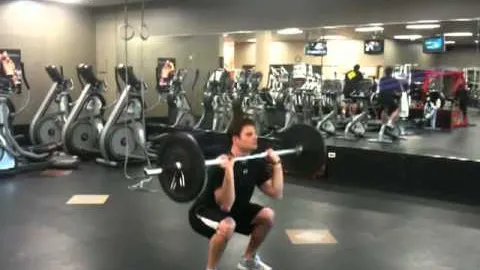
The barbell squatting shoulder press exercise is an effective compound movement that combines elements of the barbell squat and shoulder press. This exercise primarily targets the lower body muscles, including the quadriceps, hamstrings, glutes, and calves, while also engaging the shoulders and core muscles. This full-body exercise is an excellent addition to any strength training or weightlifting routine.
The barbell squatting shoulder press exercise stimulates the major muscle groups, leading to increased strength and size. The combination of squats and shoulder press allows for a wider range of muscle activation, resulting in overall muscle development.
As a compound exercise, the barbell squatting shoulder press challenges stability and balance through the involvement of multiple muscle groups simultaneously. The exercise strengthens the entire body, improving coordination and reducing the risk of injuries.
Engaging multiple muscle groups with the barbell squatting shoulder press exercise burns more calories compared to isolation exercises. This makes it an efficient choice for individuals looking to lose weight or enhance their cardiovascular fitness.
The barbell squatting shoulder press exercise mimics natural human movements, making it highly functional. It improves the strength and stability needed for everyday activities, such as lifting heavy objects and performing chores.
To perform the barbell squatting shoulder press exercise with proper form and technique, follow these steps:
Set Up
Grasp the Barbell
Squat Position
Begin the Squat
Shoulder Press
Return to Starting Position
The barbell squatting shoulder press exercise can be incorporated into your strength training routine in various ways. Here is an example of how to include it:
Warm-up
Compound Exercises
Isolation Exercises
Recovery and Stretching
The barbell squatting shoulder press exercise provides a multitude of benefits, including increased muscle strength, enhanced stability and balance, greater calorie burn, and improved functional strength. By incorporating this compound movement into your workout routine, you can achieve overall muscle development and progress towards your fitness goals. Remember to prioritize proper form and technique to maximize the effectiveness of the exercise while minimizing the risk of injury.
If you're looking for a gym, fitness club or yoga studio, you've come to the right place.
You can find information about gyms in your area. Browse catalog of gyms and find gyms with classes which are you looking for.
On gym page you can find simple information like address, phone or website. You can find list of available classes. You can check availability of personal training or small group classes. On place page you can also see information about open hours.
You can find gyms near you with amenities, courts, studios and equipments.
Use our map to find gym at your city or district.
In Gym Navigator you can find list of exercises with movies for many body parts.
You can browse exercises catalog and find exercises the best of you.
You can also find exercises grouped into workout plans, which you can use to improve you body. Each routine show you exercises one by one and give you possibility to count you progress and count down rest time.